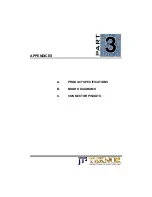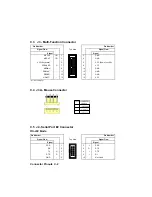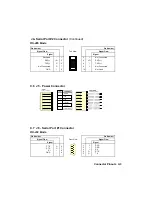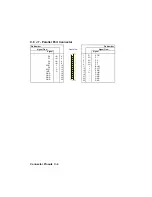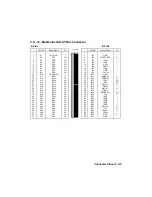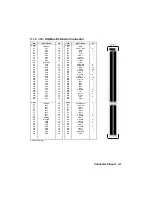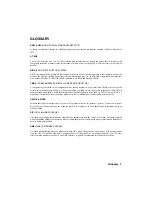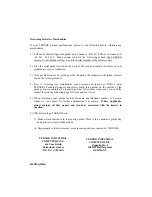
Glossary 2
DRAM
(DYNAMIC RANDOM ACCESS MEMORY)
A memory technology that is characterized by extremely high density, low power and low cost. It must be refreshed
often (every one thousandth of a second) to avoid loss of data. This type of memory is used as the system memory in
many personal computers. DRAM can be configured using 36-bit or 9-bit SIMMs (Single In-line Modules), and is
the only type of memory that can be installed by the user.
EPROM
(ERASABLE PROGRAMMABLE READ-ONLY MEMORY)
EPROM is a chip with a glass window that is useful for storing firmware. It can be erased by removing the protective
cover from the chip package and exposing the semiconductor material to ultraviolet light. It can then be re-
programmed.
EXPANDED MEMORY SPECIFICATION (EMS)
Personal computers using DOS have a RAM limitation of 640 KB, not enough for applications like spreadsheets and
multiple program loading. The EMS is a technique that establishes a set of rules for organizing and accessing
extended memory, for use as conventional DOS memory. Up to 32 MB of extended memory can be accessed through
the 64 KB window in conventional memory, divided into four 16 KB memory pages.
EXTENDED MEMORY SPECIFICATION (XMS)
In an industry-standard computer, any amount of memory above the base configuration supplied by the manufacturer.
It is the memory above 1 MB accessible only in protected mode. Microsoft Windows, Xenix, and Unix can access it
but, DOS and ordinary applications programs cannot because they must use real mode.
FLASH MEMORY
A type of EEPROM, only at a much lower cost, that can be re-programmed by the computer or peripheral device to
which it is connected. Flash memory is nonvolatile and as a result, it eliminates the risk of losing valuable data
updates. Flash memory offers major advantages in applications like automated factories, remote systems, portable
equipment and similar environments.
IDE
(INTEGRATED DRIVE ELECTRONICS)
A hard disk drive standard/protocol characterized by the integration of the controller circuitry onto the drive itself; this
reduces interface costs and allows easy implementation of a drive within a computer system.
INTERRUPT
Interrupt is a signal that stops what the computer system is currently doing, caused by a deliberate instruction to the
microprocessor. This allows the system to perform a higher priority task. After the interrupt is serviced, the
suspended microprocessor task can be resumed at the point where it stopped.
The interrupt channel is designated for receiving and transmitting interrupts, so that input/output or other operations
can take place. See IRQ.
Содержание TEK-AT4L Plus
Страница 7: ...PRODUCT DESCRIPTION 1 PRODUCT OVERVIEW 2 ONBOARD SUBSYSTEMS...
Страница 9: ...Product Overview 1 2 TEK AT4LPLUS Block Diagram...
Страница 26: ...Installing Devices 6 3 CONNECTOR LOCATION...
Страница 35: ...Setting Jumpers 8 3 JUMPER LOCATIONS...
Страница 36: ...Setting Jumpers 8 5 TABLE 8 1 Jumper Settings W1 W11...
Страница 37: ...Setting Jumpers 8 6 TABLE 8 2 Jumper Settings W12 W19 W26...
Страница 38: ...Setting Jumpers 8 7 TABLE 8 3 Jumper Settings W20 W25 SW1 SW2...
Страница 41: ...APPENDICES A PRODUCT SPECIFICATIONS B BOARD DIAGRAMS C CONNECTOR PINOUTS...
Страница 43: ...Board Diagrams B 1 B 1 TEK AT4LPLUS Assembly Diagram Top View...
Страница 44: ...Board Diagrams B 3 B 2 TEK AT4LPLUS Mounting Holes...
Страница 45: ...Board Diagrams B 5 B 3 TEK AT4LPLUS Mechanical Specifications...


